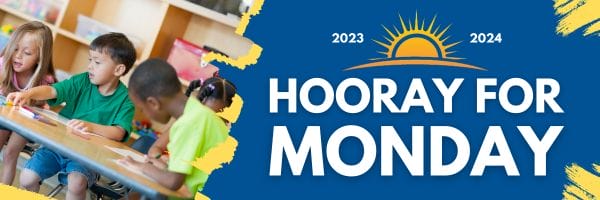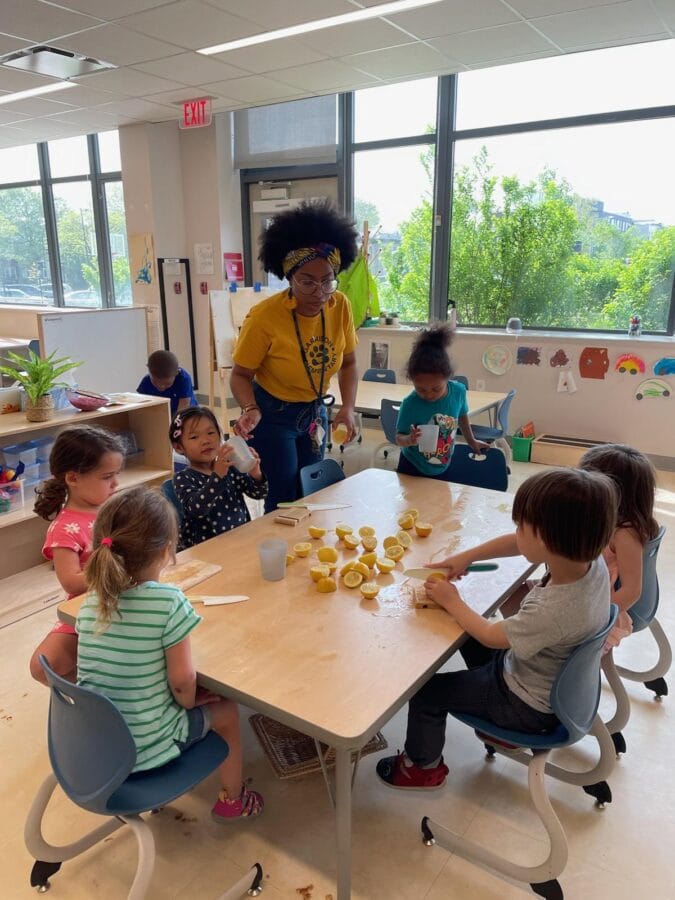Tell us a little bit about where you teach, what grade you teach, and how long you’ve been doing it.
My name is Candace Spencer, I am a pre-K3 teacher at Garrison Elementary in DCPS. This is my third year as a lead teacher. I was a para the year before and a one-on-one literacy tutor for three years before that.
If someone hasn’t worked with students the age of yours before, what are some things they should know? What makes this age group wonderful?
Oh, three-year-olds in particular are just so sweet and so lovable and so imaginative. I think it is the best age because at that age they are open to so many new things and they pick up things so quickly. So just some of the things that you hear from them are kind of amazing and the progress that you see from the beginning of the year to the end of the year is quite astounding. I don’t feel like I could credit myself with all of the progress, but it is quite amazing to be a part of.
Can you think of a specific example of one of those surprise changes that you’ve seen over time with a student?
Yeah, some of them come in with very little language at the beginning of the year, sometimes they have speech delay or maybe, at home speak a different language.
The language that we speak mostly in the classroom is English. And so by the end of the year, they’re speaking in full sentences, whereas previously they were just nodding their head or shaking their head. And even just the emotional side of it is interesting to observe because socio-emotional learning is such a big part of learning for little children especially.
You see this with the empathy piece. At the beginning of the year, at this age, they’re kind of all egocentric and that’s normal.But by closer to the end of the year, you see more of the empathy developing. They’re recognizing how another friend is feeling and that they might be feeling differently than how you’re feeling about something and even initiating helping them out.
You took the Teaching with Improvisation Institute with us this summer and I was wondering if you could talk a little bit about what that experience was like for you.
It was such a great experience. I loved everything. I really wish every adult PD was just like that with all of the movement that was incorporated. Being an early childhood educator, we’re very conscious of movement being a part of every single part of the day. But that doesn’t always translate for grownups. I think it’s because we aren’t as wiggly and so we’re expected to sit longer. So having so much movement incorporated helped a lot. And also having the space and the time to consider so many different things. Like what we wish and hope for for our kiddos, and what we wish and hope for, for ourselves as educators, and to put these things into practice. There wasn’t a dull moment.
There were lots of reminders, even for me, reminders about not squashing children’s creativity because it comes so naturally from them. And so it’s no longer me saying, “No, no, no. This is what we’re doing.” But saying instead, “Yes, and…” and kind of growing from what they’ve given, what they created, instead of saying “No, this is what we’re doing.” Now I’m incorporating what my students have said into what we’re doing. There’s always a way to say “yes, and.”
In this experience, we were really practicing improv and playing with it together as adults. And, you gave an example right there, but what are some other ways you’ve seen that experience with improv impact the work you do in the classroom?
It’s kind of helped me to frame things differently, especially in a moment that’s inconvenient for me. Like when a three-year-old’s will and purpose is different than my will and purpose in the moment. I am now able to pivot in the moment with what they’ve given me and kind of make it work for that situation.
So, if they’re saying, “I’m gonna start singing right now in large group,” I’ll sing two words of that song and say, “Oh, that’s such a fun song. Should we sing it after this?” And then they’ll say, “Yeah.” Or, they’re supposed to choose a way to sit and it’s completely different than the options that I’ve given them. I say, “Oh, that’s a cool way to sit. What should we name that?” So, instead of “crisscross” or “pencil” this is “mermaid” now. So they’re sitting like a mermaid or like a mountain. And I can now say, “I can see you’re sitting like a mountain – as long as you’re safe.”
That’s lovely. Those are beautiful examples of respecting what they’re creating in the moment. This week on the podcast, we’re exploring the last of the five rules: Embrace Mistakes. And it’s one I remember this summer that teachers liked a lot. I’m wondering what does that one mean for you as a teacher?
For me, it means making sure that my students understand that I am human as a teacher and that I’m not always right, and that I’m still learning. The goal is that it gives them space and acceptance to be wrong, and to try things that are difficult and that they can’t do the first time. So I even model how sometimes I mess up or sometimes I forget. And I’m like, “Oops, that was really frustrating for me. I’m gonna try again.” Or, “Miss Spencer made a mistake. Do you know what I did? It’s a little silly. Can I tell you?” And I’ll tell them. And they respond, “That is pretty silly.” And they’ll help me fix it sometimes.
Or even if we spill something or we break something I’m modeling with language like, “Oops! It’s just a, oops. Can we fix it? What do we do? We make a mess, we clean it up. No biggie.” Even hearing them say “no biggie” in the classroom is kind of a source of joy for us because we use it so much in the classroom.
So it’s a phrase that they’ve picked up and claimed for their own?
Yeah. “No biggie.”
“Did we spill something? Or did we drop some goldfish on the floor? What do we do? Let’s sweep it up. No biggie!”
When we are expressing frustration and we’re feeling angry in a moment and we didn’t do things the way that we’re proud of, we’re even going back and saying, “You know what? I didn’t really like the way I talked to you just then. Can I try again?” Owning that has been really helpful for me.
So that’s something you’re modeling as an adult with three-year-olds. Are they conscious of when they’re making a mistake?
Sometimes I think they are. Sometimes I think it’s a choice. Maybe I feel like it’s a conscious decision. Like, “I’m gonna do something that’s not helpful right now.” We phrase it that way. We’re careful to use language that indicates: “You’re not being bad, but the decision that you made is not helpful.” Or, “The decision that you made is not kind.” So kind of like, let’s, “Let’s try this again another way.”
Sometimes they’ll even look up, I guess because they’re used to maybe at home if they make a mess or if something’s broken, they get in trouble. And so they look up or they’ll start crying or they’ll kind of be like, “Oh no! This happened!” And so I am flipping the script where that it happens. I say, “I spill things too. I break things by accident. It’s ok. We can fix it, we can clean it up.”
That’s beautiful. And it makes me think about how helpful that insight would also have been for me as a parent in navigating those situations because parents don’t always have the tools to know how to handle those situations and, and a mess is an inconvenience and a mess gets in the way. But the way we respond to that really does teach us what it means, how, how to respond to a mistake. So thank you for that example. If you could offer our listeners one piece of advice about embracing mistakes in their own classrooms, What would it be?
I would say be your most authentic self at all times. That shows the littles how to deal with mistakes. And so even if it’s a natural response, kind of owning that and being like, “Oh, I felt so frustrated that I did this.” Or, “I forgot I had this meeting today and I need to be there. Now, I need to take a breath to calm down before I get there.”
That helps students to develop that self-talk in their head too about if they make a mistake. You’re not beating yourself up. You can try challenging things without being defeated even if it’s not done correctly the first time. That is just a part of the process of learning. We’re all still learning.


